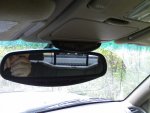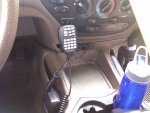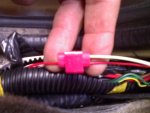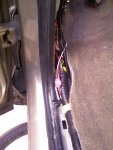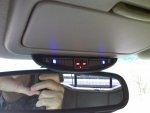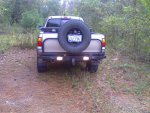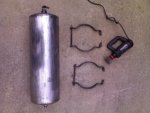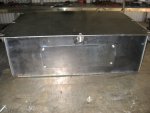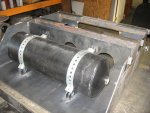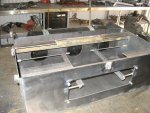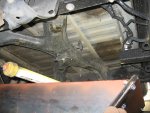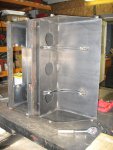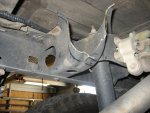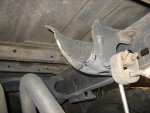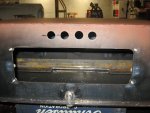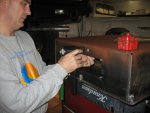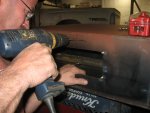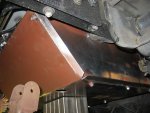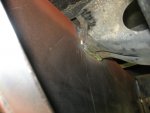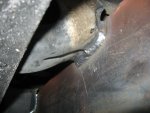RoundOut
Explorer
Wiring up the rear bumper accessories
With my new bumper, I have the backup sensors, auxiliary backup lights, license plate light and trailer wiring harness to wire up before calling this project complete. Before leaving for Tulsa this past weekend, my son and I got some of the wiring done for the accessories. For the cleanest install, I wanted to have a single primary wiring harness to fish into the cab. We wired the license plate light, backup sensors, and power wires for the backup lights all in the same dress-up kit.
First, I spliced into the factory license plate light wiring and ran a feed wire toward the passenger side and up the swing-out carrier. Then we started the primary harness from the outer PS backup sensor including the license plate wire (to it's splice in the center of the rear end), the PS auxiliary backup light and the inner PS backup sensor. Zip-tying these, we continued with the DS inner backup sensor, auxiliary backup light and outer backup sensor. As we added wires to the dress-up kit, we wrapped the whole length of harness with electrical tape for extra protection.
Because the sensors were about 15" apart across the back bumper, their respective plugs on the cicruit board end were spaced that far apart in the harness. In order to be able to fish the harness into the cab, I elected to wrap it in the dress-up kit to the ends. It took four stretched six-foot kits to get the long backup sensor wires all bundled up. After the third kit, I didn't wrap the entire dress-up tubing with electrical tape, because we knew it would be unwrapped for final installation. We just taped one wrap about every six inches.
Our final destination for the ends of the harness would be below the console. I originally thought we would enter the cab through the fire-wall up front. We started out zip-tying the harness, following the tail-light harness forward. We got to the point just below the driver's seat, and realized that it continues into the engine bay protected in some heat-resistant tubes. I didn't have any of those, so I started looking for other options. Under the seat and floorboard there were several plugs, but they would not be acceptable because of their position under foot. I found a plug in the back of the cab, about 6" above the floor where the back seat sits, and about 6" in from the side that would do the trick nicely.
We pulled that plug, cut an 'x' in it, cut about 1.5" off the lower left (as one looks rearward) portion of the plastic trim on the driver's side by the back seat to almost expose the plug (this allowed us to handle it without affecting appearance too much), put the plug around the harness, pushed the harness in the cab, reset the plug, adjusted the harness for best fit with appropriate flexibility, and then put some silicone RTV on the plug, to seal it up. We pulled up the outer edge floor step trim to expose the edge of the carpet and ran the harness forward to the kick panel.
While I had the kick panel off, I took the opportunity to wire up the Ham harness and the two other power cable harnesses I previously ran through the firewall. I put heat shrink female connectors that mated up with the battery terminal adapters that I purchased at West Marine. We pulled apart the end of the dress-up kit housing the bumper accessory wires to allow adding the power harnesses from the firewall accessory power runs. I re-wrapped it and routed it under the steering wheel and over to the console. About four to six feet of extra harness is now stored behind the lower portion of the console until we can finish this install.
With my new bumper, I have the backup sensors, auxiliary backup lights, license plate light and trailer wiring harness to wire up before calling this project complete. Before leaving for Tulsa this past weekend, my son and I got some of the wiring done for the accessories. For the cleanest install, I wanted to have a single primary wiring harness to fish into the cab. We wired the license plate light, backup sensors, and power wires for the backup lights all in the same dress-up kit.
First, I spliced into the factory license plate light wiring and ran a feed wire toward the passenger side and up the swing-out carrier. Then we started the primary harness from the outer PS backup sensor including the license plate wire (to it's splice in the center of the rear end), the PS auxiliary backup light and the inner PS backup sensor. Zip-tying these, we continued with the DS inner backup sensor, auxiliary backup light and outer backup sensor. As we added wires to the dress-up kit, we wrapped the whole length of harness with electrical tape for extra protection.
Because the sensors were about 15" apart across the back bumper, their respective plugs on the cicruit board end were spaced that far apart in the harness. In order to be able to fish the harness into the cab, I elected to wrap it in the dress-up kit to the ends. It took four stretched six-foot kits to get the long backup sensor wires all bundled up. After the third kit, I didn't wrap the entire dress-up tubing with electrical tape, because we knew it would be unwrapped for final installation. We just taped one wrap about every six inches.
Our final destination for the ends of the harness would be below the console. I originally thought we would enter the cab through the fire-wall up front. We started out zip-tying the harness, following the tail-light harness forward. We got to the point just below the driver's seat, and realized that it continues into the engine bay protected in some heat-resistant tubes. I didn't have any of those, so I started looking for other options. Under the seat and floorboard there were several plugs, but they would not be acceptable because of their position under foot. I found a plug in the back of the cab, about 6" above the floor where the back seat sits, and about 6" in from the side that would do the trick nicely.
We pulled that plug, cut an 'x' in it, cut about 1.5" off the lower left (as one looks rearward) portion of the plastic trim on the driver's side by the back seat to almost expose the plug (this allowed us to handle it without affecting appearance too much), put the plug around the harness, pushed the harness in the cab, reset the plug, adjusted the harness for best fit with appropriate flexibility, and then put some silicone RTV on the plug, to seal it up. We pulled up the outer edge floor step trim to expose the edge of the carpet and ran the harness forward to the kick panel.
While I had the kick panel off, I took the opportunity to wire up the Ham harness and the two other power cable harnesses I previously ran through the firewall. I put heat shrink female connectors that mated up with the battery terminal adapters that I purchased at West Marine. We pulled apart the end of the dress-up kit housing the bumper accessory wires to allow adding the power harnesses from the firewall accessory power runs. I re-wrapped it and routed it under the steering wheel and over to the console. About four to six feet of extra harness is now stored behind the lower portion of the console until we can finish this install.

